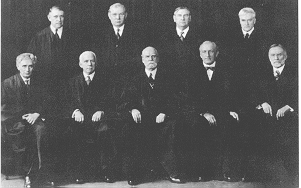The Supreme Court will come for your Social Security. Count on it
Joan
McCarter, Daily
Kos Staff
 |
| The Supreme Court has upheld the Constitutionality of Social Security in the past. But the radical Trump court puts ideology above precedent. |
Their
list of grievances against 20th-century progress isn’t going to stop with our
private lives. Not when their twin bugbears of the New Deal and Great Society
still stand. Not until they’ve completed the Great Regression. Elected officials haven’t
been able to get it done, so the unelected Supreme Court will take on the job.
Since
the Social Security Act was enacted into law on August 14, 1935, Republicans
have tried to tear it down. The thought of all that money being safely stored
away by the government to help secure dignified and sustainable retirements for
regular working people has rankled the Republicans all these decades. Elected
officials have tried and failed. 
By Mike Luckovich
Case in point: Former President George W.
Bush entered his second term in
office with a radical “reform” plan to privatize Social
Security. “I earned capital in this campaign, political capital, and now I
intend to spend it,” he declared after the 2004 election.
He really did try, and the people turned on him. “According to the Gallup organization, public disapproval of President Bush’s handling of Social Security rose by 16 points from 48 to 64% between his State of the Union address and June.” Democrats were united against his proposal and Republicans could see it was toxic, and used Bush’s post-Hurricane Katrina dive in public support to pull the plug.
Even the Very Serious People involved in all those Very Serious commissions making all their Very Serious pronouncements about how Social Security has to be “reformed” because the deficit have not been able to convince elected Republicans to finally do it. Because elections would be hard to win afterward.
So
it will be down to the unelected Supreme Court to do it, just as the Federalist
Society—which built this court with the enthusiastic assistance of Mitch
McConnell, George W. Bush, and Donald Trump—has intended all along.
Erica Suares, policy adviser to McConnell made that very clear with the confirmation of Neil Gorsuch to the seat McConnell stole from President Barack Obama and his nominee, Merrick Garland.
Trump Supreme Court nominees could “fundamentally change the country,” she said. The goal was “shifting the culture” toward a limited federal government, adding “with these lifetime appointments we can really change the country in a short period of time.”
Will Dunham, then policy
director for Minority Leader Kevin McCarthy and a Heritage Foundation alum,
said they were aiming beyond undoing Obama’s achievements at going “even
further back—all the way back to the New Deal.”
The
New Deal, and after it, LBJ’s Great Society, are definitely on the chopping
block once civil rights have been done away with. It’s been the plan for
decades, as described in
2018 by People for the American Way’s Peter Montgomery.
Throughout its history, a central focus of Federalist Society members has been developing and promoting a pre-New Deal understanding of federalism. A 1998 student conference focused on the structure of the Constitution, including “undoing the New Deal.” In 2001, the society sponsored a conference called “Rolling Back the New Deal.”
It featured a presentation by law professor Richard Epstein called “The
Mistakes of 1937”—a reference to the Supreme Court adopting a more expansive
interpretation of the Commerce Clause. Epstein, an influential Federalist
Society figure, has also promoted an extreme view of “takings” doctrine under
the Fifth Amendment, which he admitted in a book on the topic would effectively
invalidate most laws passed in the 20th Century.”
All
of that built on the shaky foundations of
“originalism,” now the prevailing constitutional theory of the
Court. This “once […] fringe intellectual concept, confined to conservative
legal circles,” has “achieved its ultimate ascendance,” writes Joshua Zeitz who
will soon release Building the Great Society: Inside Lyndon Johnson’s
White House.
“The
theory, which views jurisprudence as frozen in time, flatly rejects the idea of
the Constitution as a living and evolving document and instead demands that we
interpret its provisions exactly as the framers intended,” he explains, even
though the execution of that theory in supporting radical decisions is at best
sloppy and at worst a complete misreading of actual history and prevailing
thought at the founding.
“Curiously,
in the space of 24 hours, the court’s majority moved the goal posts—1790s for
guns, 1850s or so, for abortion—in determining what historical standard should
inform the boundaries of constitutional exegesis,” Zeitz writes. They also
reversed themselves on the idea of states’ rights in that 24 hours—the state
has no authority whatsoever when it comes to guns, all the authority when it
comes to abortion. At least until a Republican Congress passes a national ban
on abortion. That they’d uphold.
This
is a court that will have absolutely no compunction about declaring Social
Security unconstitutional—and with it, Medicare and Medicaid and most of the
safety net. The foundation on what passes for intellectual thought in the far
right to do so has been built. All it’s going to take is the right set of
challenges, which Trump-packed federal courts will happily provide.
Unless
they are stopped.